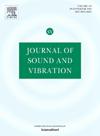Reinforcement learning vibration control of moving three flexible coupled beams
IF 4.3
2区 工程技术
Q1 ACOUSTICS
引用次数: 0
Abstract
A multi-agent reinforcement learning (RL) vibration controller is designed to actively suppress the vibration of a three-flexible coupled moving beam system and optimize the translational motion trajectory to minimize the residual vibration after motion. The finite element method is used to model the dynamic equation of the system, and the parameters of the actual model are identified by wavelet transform and intelligent optimization algorithm. A structured light visual vibration detection system is constructed to measure the vibration of three flexible beams. Based on the modified model, a trajectory optimization method of the three-flexible beam coupling system based on neural network optimization algorithm is designed. The QMIX and phasic policy gradient (PPG) controller are trained to obtain excellent nonlinear controllers for vibration control of piezoelectric actuators. The simulation and experimental results show that the optimized trajectory greatly reduces the vibration excitation, and the vibration at the end of the translation and movement is quickly suppressed. For the dual flexible beam coupled system, the designed QMIX controller suppresses the vibration completely in about 7 s, while under large gain proportional and derivative (PD) control, there is still residual vibration in 20 s. For the vibration of the first bending mode of the single flexible beam system, the designed PPG controller completely suppresses the vibration in about 3 s, while the vibration attenuation takes about 10 s for the large gain PD control. For the vibration of the first two bending modes, the PPG controller completely suppresses the vibration in about 4 s, while it takes about 11 s for the large gain PD control. The control effects of the two RL methods are better than that of PD control, especially for suppressing small amplitude vibration.

运动三柔性耦合梁的强化学习振动控制
设计了一种多智能体强化学习(RL)振动控制器,以主动抑制三柔性耦合动梁系统的振动,并优化平移运动轨迹,使运动后残余振动最小化。采用有限元法对系统动力学方程进行建模,并采用小波变换和智能优化算法对实际模型参数进行辨识。构造了一种结构光视觉振动检测系统,用于测量三根柔性梁的振动。在修正模型的基础上,设计了一种基于神经网络优化算法的三柔性梁耦合系统轨迹优化方法。通过对QMIX和相位策略梯度(PPG)控制器的训练,得到了用于压电致动器振动控制的优秀非线性控制器。仿真和实验结果表明,优化后的轨迹大大降低了振动激励,平移和运动结束时的振动得到了快速抑制。对于双柔性梁耦合系统,所设计的QMIX控制器在7 s左右就能完全抑制振动,而在大增益比例导数(PD)控制下,20 s左右仍有残余振动。对于单柔性梁系统第一弯曲模态的振动,所设计的PPG控制器在3 s左右完全抑制了振动,而对于大增益PD控制,振动衰减大约需要10 s。对于前两种弯曲模态的振动,PPG控制器在约4 s内完全抑制了振动,而大增益PD控制则需要约11 s。两种RL方法的控制效果都优于PD控制,特别是在抑制小振幅振动方面。
本文章由计算机程序翻译,如有差异,请以英文原文为准。
求助全文
约1分钟内获得全文
求助全文
来源期刊

Journal of Sound and Vibration
工程技术-工程:机械
CiteScore
9.10
自引率
10.60%
发文量
551
审稿时长
69 days
期刊介绍:
The Journal of Sound and Vibration (JSV) is an independent journal devoted to the prompt publication of original papers, both theoretical and experimental, that provide new information on any aspect of sound or vibration. There is an emphasis on fundamental work that has potential for practical application.
JSV was founded and operates on the premise that the subject of sound and vibration requires a journal that publishes papers of a high technical standard across the various subdisciplines, thus facilitating awareness of techniques and discoveries in one area that may be applicable in others.
 求助内容:
求助内容: 应助结果提醒方式:
应助结果提醒方式:


